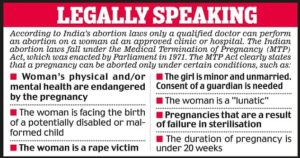Law on Abortion in India and its Complexities
Medical Termination in India:
Medical termination of pregnancy has been a time-honored practice. Approximately 26 million pregnancies are terminated legally throughout the world, and 20 million are terminated illegally, with more than 68,000 deaths. In India alone 10-12 million abortions take place annually, resulting in 15-20 thousand maternal deaths, mainly due to illegal abortions. So these abortions don’t just take away the innocent infant’s life but also pose a threat to the mothers’ lives insinuating one of the most major social problems.
Law on Abortion in India:
An abortion is the removal or expulsion of an embryo or foetus before it can live independently. It could be a spontaneous process referred to as miscarriage or artificially induced medicines, surgery etc. usually before 20 weeks of gestation.
The law relating to abortion was provided in the Indian Penal Code under Section 312 which punishes the mother or any person who causes miscarriage except if it is done in good faith in order to protect a more precious life that is, the mother’s life.
As the position was considered unsatisfactory, on the recommendations of the Abortion Study Committee, 1966, the parliament discussed and passed the Medical Termination of Pregnancy Act, 1971.
Medical Termination of Pregnancy Act, 1971:
Medical Termination of Pregnancy Act, 1971 was a pretty modern step for that age. The Act legalised medical termination of pregnancy up to 20 weeks of gestation by medical practitioners. The purpose of the Act was to protect women who wanted to undergo abortion from legal hassles. In the process, it aimed to regularise institutions relating to abortion and reduce the number of illegal abortions.
However, the purposes of the Act did not materialise and the counts of illegal abortions only increased after its enactment in 1971. One may ask how an Act that provides for place of termination, time of termination, qualifications etc., fail to execute its aims. I have discussed some of the reasons below.
Drawbacks in the Act:
One of the major drawbacks of the MTP Act, 1971 was that the women weren’t in control of the decision making process. There are two eventualities under which a women can undergo abortion. They are:
(i) Length of the pregnancy does not exceed 12 weeks,
(ii) Length of pregnancy exceeds 12 weeks but does not exceed 20 weeks.
In the first eventuality, termination can be conducted only with a good faith of the medical practitioner that the continuation of the pregnancy is a danger to the woman or that there is substantial risk that that the child would be physically or mentally ill, whereas the second eventuality requires the good faith of at least two practitioners.
Therefore, ultimately the decision as to whether she can undergo abortion lay with the doctors. This shifted the entire attention to a woman’s right to choose the conditions of her own child-bearing.
(Picture Credit: IAS Baba)
This aspect of the law conveyed to the world that while the Act was enacted to promote public health by reducing unnecessary births leading to over-population, it gave less importance to the rights of the women. So, the law in India differed from similar laws abroad like in US, which had a more feminist approach, associated with giving women equal status in the society.
Another major problem was that while the Act provided for the qualification a doctor or practitioner needed to have in order to carry out the procedure, lack of proper infrastructure, planning and awareness lead to large number of illegal abortions.
These qualified doctors are available only in urban areas and there is a dearth of such doctors in the rural areas. The National Level Facility Service revealed that out of all the primary health centres, only 15% have MTP trained doctors. Moreover, so many women in rural areas still think that abortion is illegal. Due to these reasons, women in the rural areas approach midwives or untrained doctors and undergo illegal abortion posing serious risks to their lives.
Medical Termination of Pregnancy (Amendment) Bill, 2014:
With some comforting prospect, the Government of India released the draft of the Medical Termination of Pregnancy (Amendment) Bill on 29th October, 2014. The bill increased the gestation limit from 20 weeks to 24 weeks.
This was mainly engendered due to the case filed by Niketa and her husband Harsh in the Bombay High Court seeking an order allowing her to abort her foetus that was suffering a congenital heart disease, which was found in her 22nd week of pregnancy. The court refused her plea. However, she later suffered a miscarriage and gave rise to a nationwide debate on abortion laws. Several doctors were of the opinion that heart anomalies or other kinds of defects in the foetus can be identified only during 20-24th week and parents should be allowed to opt for abortion if it is safe.
The 2014 Amendment also gives the women complete autonomy on abortion in the first trimester and provide for only one practitioner’s approval instead of two in the second trimester. It also expands the base to midwives and non-physician practitioners.
These changes are a positive move towards recognising women’s rights, preventing their suppression and, it shifts the law from being pro-practitioners to pro-women. The expansion to midwives and practitioners will hopefully cut down the number of illegal abortions tremendously if they are well trained. The authenticity of its success can only be proved once the rules are out and also on how the Government implements these ideas.
Present status on the law on abortion in India:
Supreme Court Case on abortion, 2016:
Even though the draft amendment bill was out in 2014, there has been no progress post that. However, like a knight in the shining armour, the Supreme Court of India in a case on Monday, 25th July, 2016 allowed a rape victim to abort her abnormal 24 weeks foetus on the premise that the pregnancy would endanger her physical and mental health. The victim was given relief under Section 5 of Medical Termination of Pregnancy Act, 1971 which provides that abortion after 20 weeks is allowed if it is immediately necessary to save the life of the pregnant woman.
Even before this, Supreme Court of India had allowed a 14 years old rape victim to undergo abortion after the 20 weeks deadline. However, the petition was treated as a special case which means that the case could not be used as a precedent in other cases. It is because of this that the victim in the 2016 case had to approach the Supreme Court afresh.
The debate around MTP Act rekindled when a 22year old girl from Thane wanted to undergo abortion in the 23rd week of her pregnancy. Her doctor advised the court to intervene. The baby suffered from anecephaly, which is a life threatening disease. The baby would only survive in utero and there were no chances of survival after birth. KEM hospital submitted a radiology report to confirm the same. Supreme Court allowed the woman to undergo abortion by again invoking Section 5 of the MTP Act.
Conclusion:
What is unsettling about this judgement is that even though the Supreme Court meant well for the victim and passed a favourable judgement. The judgment was based on Section 5 of the Act, suggesting that a woman can only undergo abortion if there is a threat to her life. The court did not dwell in to the constitutional aspect of abortion and the ceaseless doubts posed on the limitation of the laws at present.
The law in India does not give a woman right over her own body. Even though the 1971 Act was passed in order to legalise abortion. The provisions of the Act ultimately left the choice to the practitioners instead of the woman herself. The fact that the Supreme Court chose to not dwell into the issue of the woman’s right to life, liberty and right to privacy is deeply dismaying.
With the rise in sexual abuse crimes, it is important that MTP Act be amended at the earliest. Also, because most defects in the foetus are only identified after the 18th week of pregnancy. Besides, abortions take place in the absence of legal approval in the most unhygienic conditions putting the womens’ lives at risk.
Picture Credit: Walk for Life WestCoast








